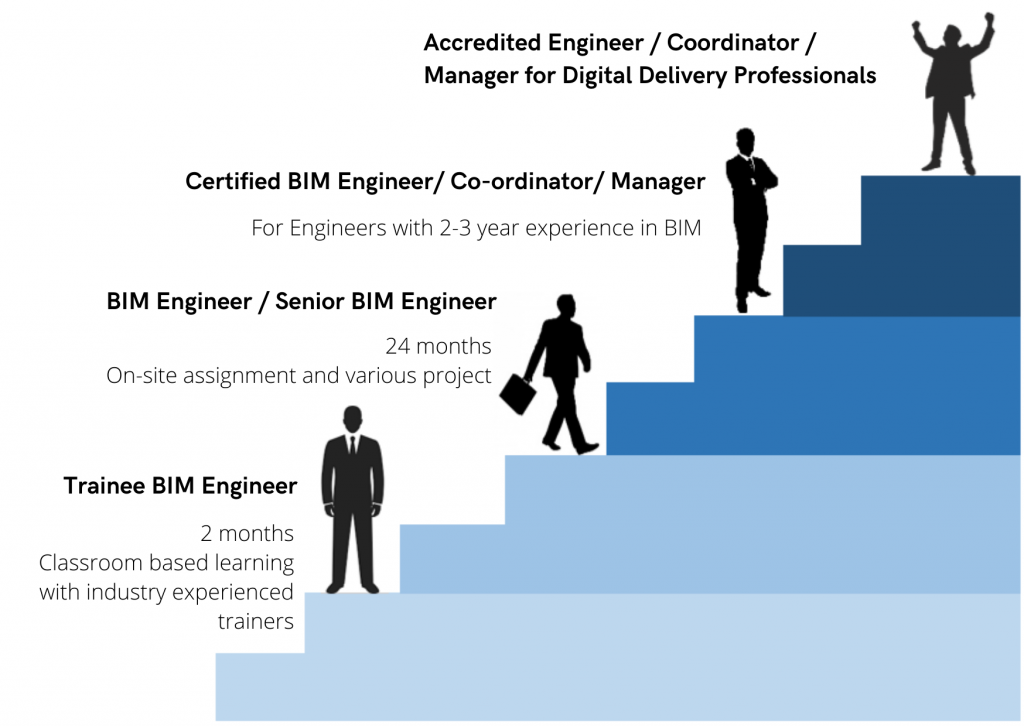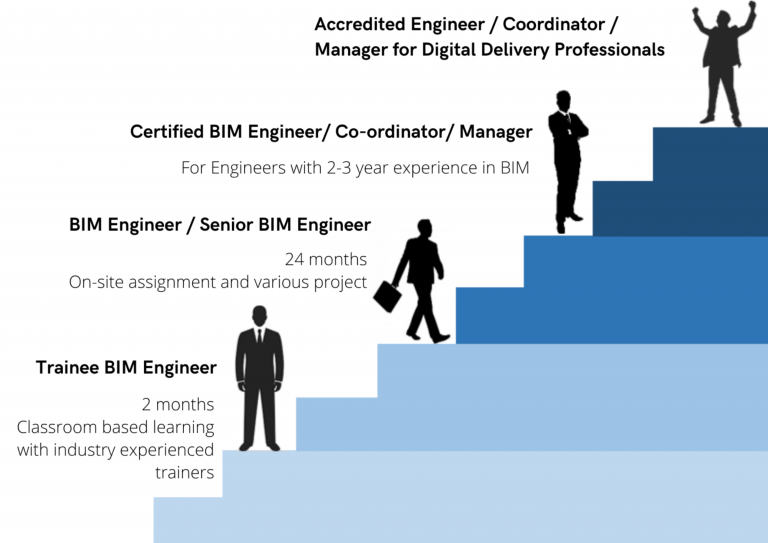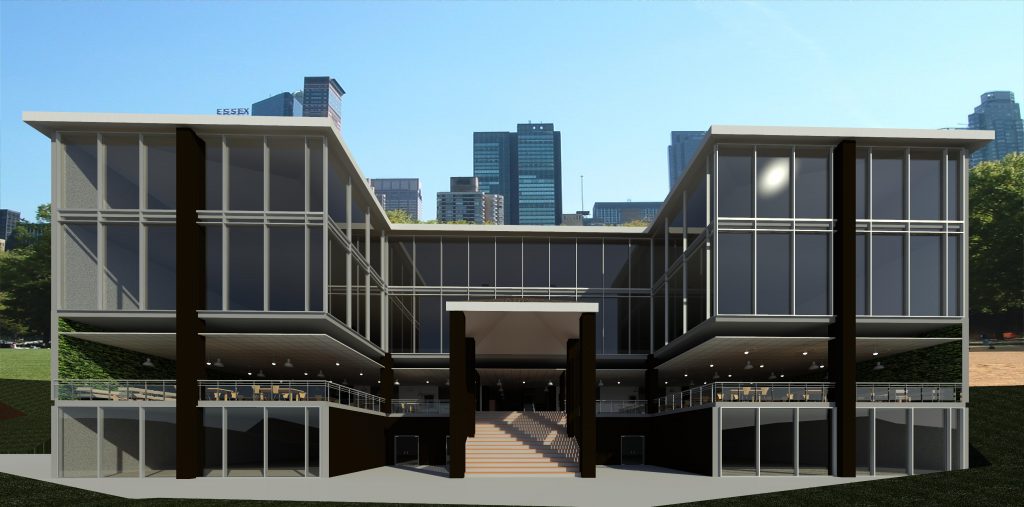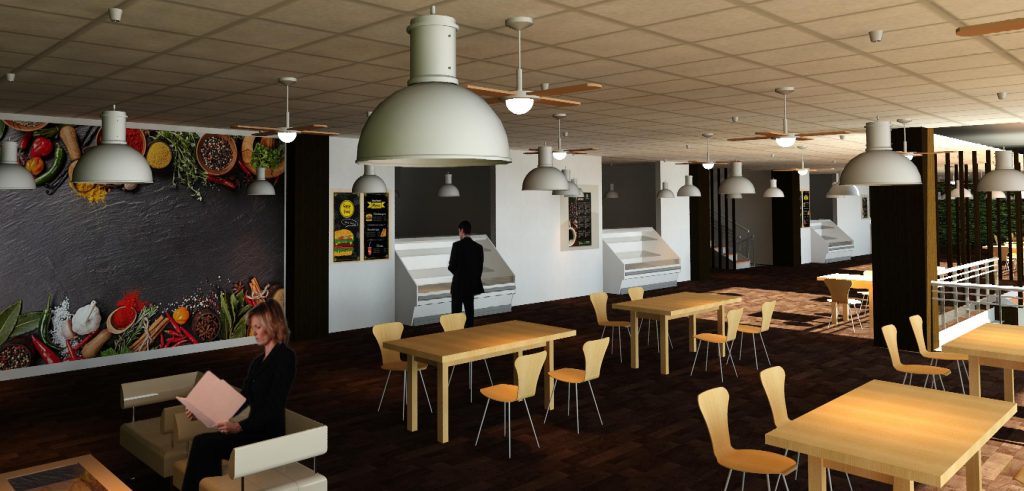

Entry Requirements

Benefits of BIM in Electrical Engineering
Coordination: BIM improves coordination among project disciplines, reducing clashes between electrical systems and other building components.
Visualization: BIM provides 3D visualization of electrical systems, aiding design understanding and stakeholder communication.
Clash Detection: BIM software identifies conflicts between electrical systems and other building elements early, minimizing rework during construction.
Quantification and Estimation: BIM generates accurate quantity takeoffs and cost estimates for electrical components, aiding budgeting and cost tracking.
Energy Efficiency Analysis: BIM tools simulate electrical system performance, enabling engineers to optimize designs for energy efficiency.
Collaboration: BIM fosters collaboration among stakeholders, improving communication and decision-making.
Lifecycle Management: BIM supports documenting and managing electrical systems throughout the building’s lifespan.
Design Iterations: BIM allows rapid design iterations, optimizing electrical system performance.
Compliance Checking: BIM software automatically checks electrical designs against building codes, ensuring compliance.
Documentation and Reporting: BIM generates detailed documentation and reports for electrical systems, facilitating construction and maintenance.
Role Of An Electrical Engineer In AcePLP
Fresh Electrical Engineering graduates and mid-careerists with no prior work experience will complete 2 months of classroom training in BIM and CAD applications. The training is conducted by Ace Industry Academy (AIA), the official training arm of AcePLP, and will prepare you as you embark on your career as a Electrical BIM Engineer. AIA is an SSG/WSG approved training provider, and some modules which you attend during this period will be WSQ-accredited, and in line with the national skills framework for the Built Environment. (SSG/WSG is a statutory council formed by the Ministry of Manpower and Ministry of Education.)
Certificates will be awarded on completion of classroom training, and thereafter, you will be assigned to work on electrical engineering-related projects to gain experience. To guarantee a smooth transition, AcePLP pairs freshly trained BIM engineers with senior colleagues or Alumni. Trainers will also be on hand to assist the new Engineers if they run into any challenges. The experience you gain from participating in projects can be used towards the Digital Delivery Management Accreditation Scheme.
As an electrical engineering graduate, your role in the projects will include serving clients that are main contractors with mechanical and electrical (M&E) departments, or you may be assigned to work with offices that provide engineering design and consultancy services, creating data-rich BIM models. With BIM, contractors can build electrical 3D BIM models of power supply, lighting, duct banks, power feeders, branch circuits and more.
This entry-level engineering job is ideal for new graduates, but as you learn and progress in the digital delivery services role, you may be moved into assignments that require a great deal of integration and coordination with other stakeholders, because the role of design and construction is often a collaboration between consultants, contractors, and specialists.
Coordinated BIM models in this area can be used to avoid material waste, rework, and better plan the execution of the project. Add-ons to popular BIM tools such as Revit can help produce automated detailing of shop drawings.
What You Will Learn On The Job
Through our training programme, we ensure that you gain the ability to use the most popularly used BIM application software in Singapore, which are Autodesk Revit, Bentley OpenBuilding, OpenRail and OpenPlant. This gives you the flexibility to work on various kinds of building and infrastructure projects in Singapore. We will also cover the use of 2D products such as AutoCAD and MicroStation, which are crucial for the documentation of the BIM models.
As when opportunity arises, we will put you through training in 4D BIM products, combining the BIM model with a Microsoft Projects or Primavera P6 schedule using products such as Synchro 4D or Navisworks Manage, enabling you to deliver on Virtual Design and Construction processes. You may undergo other types of training depending on your interest and where the opportunities take you.
Career Progression As An Electrical Engineering Professional
You can progress in this track to become an expert DDM professional, rising in the ranks to become a Tier 2 (Lead) BIM Manager, where you will play leading roles in project delivery, digital solutions and adoption, competency building and innovation to organisations or project teams in the Built Environment.
At the height of your career in the DDM (BIM) track, you can aspire to be a Chief Digital Officer (Tier 1), a C-suite role where you will oversee the implementation and innovation of digital solutions to achieve digital transformation in the business, leading the strategic direction in your team.
Alternatively, you can move into other tracks in the Built Environment that is of interest to you, such as in Architecture, Engineering Design and Consultancy, Construction and/or Project Management. With a domain knowledge grounded in construction through the experience in projects, armed with a spatial awareness via your 3D modelling and visualization skills, you can enter other tracks to continue to build domain expertise and experience.
Within the Electrical Engineering domain, you have built an advantage in using the BIM to enhance productivity as you will use your skills for clash detection, change management, data management, and simulations of building performance in all of your future projects.
For information regarding the DDM Accreditation Scheme, visit building SMART Singapore.
Career Pathway of Electrical Engineers To Accredited Digital Delivery Management (BIM) Professionals

How Does BIM Elevate the Job Prospects of
Electrical Engineering Graduates?
Technical Skills Enhancement:
BIM requires a deep understanding of software tools like Revit, AutoCAD, or Navisworks, which are commonly used in the construction industry. Electrical engineering graduates can leverage these tools to design, simulate, and analyze electrical systems within building structures. By mastering BIM software, graduates can create accurate models of electrical layouts, including wiring, lighting, and power distribution, ensuring efficiency and safety in building design.
Collaboration Opportunities:
BIM fosters interdisciplinary collaboration among architects, engineers, contractors, and other stakeholders involved in the construction process. Electrical engineering graduates proficient in BIM can effectively communicate and coordinate with professionals from different fields, contributing their expertise to integrated project delivery. This collaboration streamlines workflows, minimizes errors, and enhances project outcomes by ensuring that electrical systems align seamlessly with architectural and structural elements.
Innovation and Problem-Solving:
BIM encourages innovation in electrical engineering by enabling graduates to explore alternative designs, analyze performance metrics, and identify optimization opportunities. Through parametric modeling and simulation, engineers can evaluate the impact of design choices on energy efficiency, sustainability, and cost-effectiveness. By embracing BIM, electrical engineering graduates can leverage advanced tools and methodologies to solve complex challenges, such as integrating renewable energy sources, implementing smart building technologies, or optimizing electrical load distribution.
Project Management Skills Development:
BIM equips electrical engineering graduates with valuable project management skills essential for overseeing the entire lifecycle of construction projects. From initial design and planning to construction and maintenance, BIM facilitates project coordination, scheduling, and cost estimation. Graduates with BIM expertise can take on leadership roles, managing interdisciplinary teams and ensuring project milestones are met on time and within budget.
Competitive Advantage in the Job Market:
As the construction industry increasingly adopts BIM as a standard practice, employers seek candidates with BIM proficiency across various disciplines, including electrical engineering. Graduates who possess BIM skills distinguish themselves in the job market, demonstrating their readiness to tackle modern challenges in construction projects. Whether pursuing careers in consulting firms, engineering companies, or construction management, electrical engineering graduates with BIM expertise have a competitive edge and greater opportunities for career advancement.
Other Available Positions

IT Systems Engineer
Manage our existing network infrastructure and develop IT Solutions for clients to meet their business needs.

Human Resources
Engage with aspiring young engineers and develop policies and initiatives that nurture a learning environment.

Sales
Be part of a team sourcing out the best opportunities for talent development, and help us create valuable networks in the industry.

Production Operator
Collaborate on our print production line and delivery services




